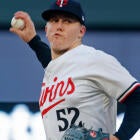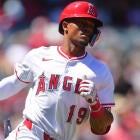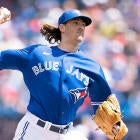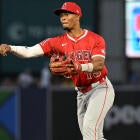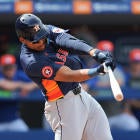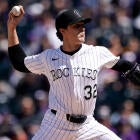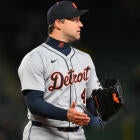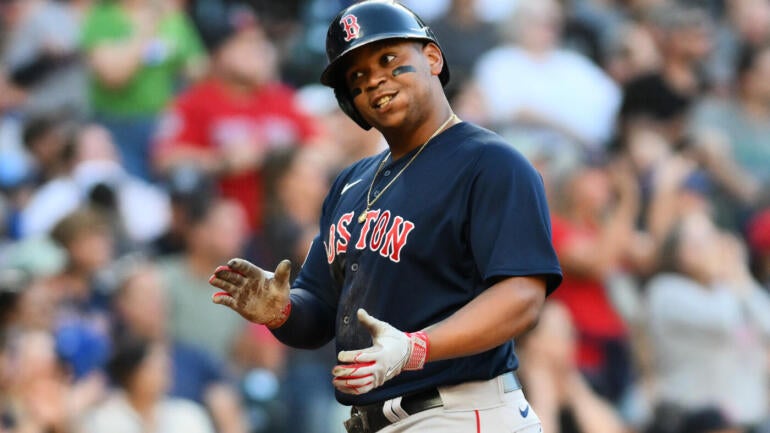
Rafael Devers began the season 0 for 19 with 15 strikeouts.
So completely was he written off that you couldn't have even dumped him in a trade. He was damaged goods, a waste of a pick, the reason you'll never be good at Fantasy Baseball.
That was less than a week ago. He's gotten exactly the same number of at-bats since then, and in them, he's gone 10 for 19 with three doubles, a home run and just two strikeouts. Two of the doubles and the home run came in a doubleheader Sunday in which he had six batted balls of 103 mph or more.
Yeah ... I'm thinking he's back.
| ||||||||||
That's just one example, but it's so demonstrative of how baseball works. We're always trying to force basketball sensibilities onto baseball, for whatever reason. You know how in basketball, a player has a small range of outcomes on any given night? Sure, he'll have better or worse nights, but after just a week or two of letting things play out, you'll come to know exactly what he's going to contribute statistically, barring a change in role.
Conversely, the outcomes for a baseball player on a given night range from best player in the league to worst player in the league. Anyone who sticks around long enough will at some point look like both, making his overall worth mostly a matter of how often he performs like either.
Over the course of 162 games, those outcomes aren't going to be arranged in any orderly way. If anything, the bad outcomes will tend to bunch together, and the same with the good outcomes. It's why you never want to be too quick to size up a player at the start of the year, particularly one with a proven track record.
Yet for some reason, longtime Fantasy Baseball players -- or just baseball fans in general -- have to re-learn this lesson every year. I suppose it's human nature. After all the buildup and anticipation of a new season, we want to be able to grasp everything right away -- to say, "OK, I guess this is how things are going to go" -- but it doesn't work that way.
Devers is a demonstrative case for a couple different reasons. The first is that there actually were extenuating circumstances that raised the concern level for him. He played all of last season with inflammation in both shoulders and never had it addressed via surgery or some other means. He showed up to spring training not ready to swing a bat yet. The Red Sox suddenly didn't trust him to make throws at third base anymore. And then when the regular season started, he was striking out every at-bat and registering lower bat speeds than usual. Not good!
Here's the thing, though: He had played in just five spring training games. His timing was obviously off, and the Red Sox said as much. No one in the organization, all the way down to Devers himself, hinted that he wasn't healthy, and on the matter of bat speed, as measured by Statcast, the statistic isn't even a year old yet. We don't have a real frame of reference for it, nor do we understand how much fluctuation is typical.
All of those justifications, though, pale in comparison to this one: He's Rafael Devers, a stud third baseman and one of the league's top hitters from the time he was 22 years old. That outcome may not have been as much of a lock given the extenuating circumstances, but if you could bet on just one outcome for Rafael Devers, it should be that he's still Rafael Devers.
And if that was still best bet even with everything he had going on, what does that say about your struggling stud?
I mentioned there's a second reason why Devers' case is so demonstrative, and it's this: His turnaround was so immediate and so complete that it underscores how wildly player outcomes can fluctuate in baseball. Again, the whole ordeal -- from him being a laughingstock washed-up has-been to totally fine -- transpired over the course of one week. It could have taken six, and for some of the "sure things" selected in this year's draft, it will.
Case in point, here's where things stood for several notable players six weeks into last season:
| AVG | HR | OPS | AB | |
|---|---|---|---|---|
Alex Bregman
BOS 3B
| .189 | 1 | .520 | 127 |
Lawrence Butler
ATH RF
| .174 | 2 | .559 | 92 |
Corbin Carroll
ARI RF
| .204 | 2 | .567 | 155 |
Jackson Chourio
MIL LF
| .221 | 4 | .610 | 113 |
Corey Seager
TEX SS
| .230 | 3 | .613 | 139 |
Francisco Lindor
NYM SS
| .211 | 6 | .670 | 142 |
Vladimir Guerrero
TOR 1B
| .246 | 4 | .717 | 142 |
Matt Olson
ATL 1B
| .200 | 3 | .665 | 125 |
Pretty wild with 20/20 hindsight, huh? We obviously know now that those players turned out fine, but it wasn't so obvious on May 8 of last year. And it sure puts those struggles for Francisco Lindor, Austin Riley, Corey Seager, Anthony Santander and Willson Contreras here on April 7 into perspective, doesn't it?
Chances are they're all fine. I can't guarantee it, of course. Sometimes, high-end players genuinely do bust, but it's the exception rather than the rule. And more to the point, it'll take some time to confirm it. You can't know for another month, at least, and if your my investment level is high enough, you'll want to give it more like two.
Does anyone who had Corbin Carroll last year want to vouch for me here? The guy was batting .192 with a .557 OPS as late as June 5 and then was the No. 2 outfielder the rest of the way. Imagine giving up on that!
Turns out you can imagine it because Devers condensed the whole experience for you. Just a week ago, all the loudest voices were proclaiming he was finished, ruined, a cautionary tale for those who ignore spring training warning signs. And now he's ... fine. Totally fine. Given that you won't find a player with a worse stretch of at-bats than his first 19, nor one with a clearer concern than his two bum shoulders, Devers' first week-plus is the perfect case study in how abruptly and completely a player's outlook can shift.
Trust in the track record. If a proven player is healthy enough to play, he'll almost certainly play his way through whatever he's dealing with. That's the lesson here.
![[object Object] Logo](https://sportshub.cbsistatic.com/i/2020/04/22/e9ceb731-8b3f-4c60-98fe-090ab66a2997/screen-shot-2020-04-22-at-11-04-56-am.png)



















